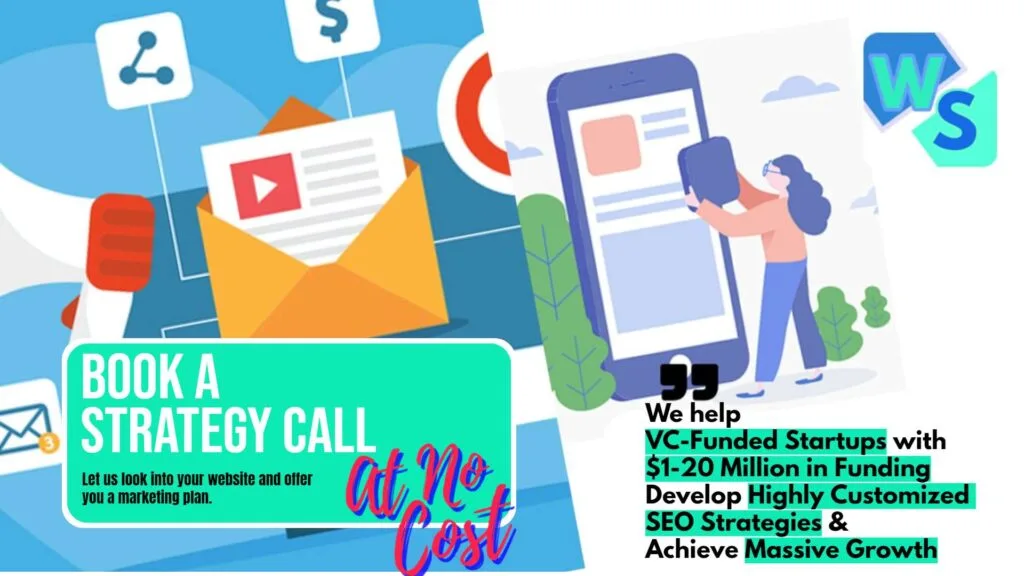This Article has been revised, edited and added to, by Poulomi Chakraborty.
- Understanding the Startup Ecosystem
- Laying the Digital Foundation: Website and SEO
- Harnessing the Power of Social Media
- Email Marketing: Direct Communication Channels
- Content Marketing: Crafting Valuable Narratives
- Pay-Per-Click (PPC) Advertising: Targeted Reach
- Leveraging Influencer Collaborations
- Localization and Global Strategies
- Chatbots and AI-Driven Engagement
- User Experience (UX) & User Interface (UI) in Digital Marketing
- Interactive Content for Enhanced Engagement
- Personalization and Tailored User Journeys
- Voice Search Optimization
- Interactive and Dynamic Emails
- Conclusion: Charting the Path to Startup Success with Digital Marketing
In the exciting world of startups, where innovation meets entrepreneurship, digital marketing emerges as a powerful ally. As new ventures strive to make their mark in crowded markets, a robust digital marketing strategy can be the wind beneath their wings, propelling them towards visibility, engagement, and growth. This article delves into the essential digital marketing strategies that startups can harness for impactful growth.
Understanding the Startup Ecosystem

Navigating the Competitive Landscape
When launching a startup, understanding the broader business environment is crucial. This isn’t just about knowing your competitors, which is essential, but also about understanding the market forces at play.
For a new startup, begin by identifying your direct competitors, those offering similar products or services, and your indirect competitors, those whose offerings can substitute yours. This is where you start to sketch out your unique value proposition.
Analyze your competitors not just to emulate them, but to surpass them. Observe their marketing strategies, sales approach, customer service, and even their social media presence.
What are they doing well? Where do they fall short? How are their customers responding? Use this information to refine your offering and ensure it stands out. This can mean integrating better technology, creating more engaging content, or offering superior customer service.
Beyond competitors, understanding market trends is equally important. This includes staying informed about changes in consumer behavior, technological advancements, and regulatory changes that could affect your business. This proactive approach enables you to adapt and innovate, ensuring your startup remains relevant and competitive.
Leveraging Local and Global Insights
Startups often overlook the importance of scaling both locally and globally. While your immediate goal might be to establish a strong local presence, global scalability should be part of your long-term strategy. Start by understanding the local market demands and cultural nuances which can vastly influence your product’s reception.
On the global front, cultural sensitivity and market understanding are key. For instance, a marketing message that works well in North America might not resonate in Asia due to cultural differences. Thus, customizing your products or services to fit different regional demands can open up additional revenue streams and reduce dependency on a single market.
To successfully manage both local and global markets, consider employing or consulting with experts from those regions. Additionally, use data analytics to gain insights into each market’s preferences and behaviors. This dual focus ensures that while you grow roots in your local community, you’re also planting seeds in international markets.
Building a Resilient Brand
In today’s fast-paced market, building a resilient brand is more important than ever. This doesn’t just mean having a memorable logo or an attractive color scheme. Your brand needs to represent something bigger—a mission, a vision, and values that resonate with your target audience.
Communicate your brand story through every possible channel. This story should encapsulate who you are, why you started your company, what you stand for, and where you aim to go. It’s about creating emotional connections with your audience. When customers understand and relate to your story, they’re more likely to become loyal advocates for your brand.
Moreover, in the digital age, your brand’s online reputation is vital. Regularly engage with customers on social media, respond to reviews, and manage any negative feedback promptly and diplomatically. This shows that you value customer feedback and are committed to continuous improvement.
Harnessing Technology for Strategic Advantage
In the digital era, leveraging technology is non-negotiable for startups. It’s not just about having a business website or an app, but about integrating advanced technologies like AI and big data to gain strategic insights and automate processes.
For instance, use AI to personalize your marketing campaigns. AI algorithms can analyze customer data to predict buying patterns and preferences, allowing you to tailor your marketing messages to individual customers. Big data analytics can also provide insights into market trends and customer behaviors, helping you make informed decisions quickly.
Additionally, consider cloud solutions to reduce costs and increase operational efficiency. Cloud technology provides scalable resources, meaning you can adjust your usage based on business needs without investing heavily in physical infrastructure.

Strategic marketing is about having a comprehensive gameplan aligned with your business objectives, rather than just tactics. Too many companies lack this cohesive approach.
One standout example I saw was our total rebrand a few years ago. We did deep customer/market research to understand positioning, then mapped out a unified strategy driving everything from messaging to product to sales motions. It transformed our impact.
For the future, AI can provide useful analytics and automation capabilities to strategic marketers.
But it can’t replace the human strategic vision, creativity and emotional intelligence needed to develop integrated marketing strategies that truly resonate.
The ideal is blending AI’s data-crunching strengths with the irreplaceable strategic mind of skilled marketers.
Let machines augment, but not supplant, the high-level strategic thinking required for impactful marketing planning. A balance of technology and human smarts is key.
Gagan Saini, CEO of JiT Home Buyers
Laying the Digital Foundation: Website and SEO
Crafting a User-Centric Website Design
For startups, the initial focus when establishing an online presence should be on creating a user-centric website. This involves designing a site that is not only visually appealing but also highly functional and easy to navigate. Consider the user journey from start to finish. What is the first thing they see? How easy is it for them to find information about your products or services? Is the checkout process straightforward for e-commerce sites?
Prioritize the mobile experience. With the increasing prevalence of smartphones, more people are accessing websites from their mobile devices. Ensure that your website design is responsive, meaning it adjusts seamlessly to different screen sizes. Google also prioritizes mobile-friendly websites in its search results, which brings us to the importance of SEO.
Integrating SEO from the Start
Search Engine Optimization (SEO) should be an integral part of your website development process, not an afterthought. Start by conducting thorough keyword research to understand what potential customers are searching for related to your offerings. Use these insights to guide your content creation, from the headlines to the body text on your website. Keywords should be integrated naturally, as Google penalizes over-optimization, often referred to as keyword stuffing.
Structure your website with clear, logical navigation and use URL slugs that reflect the hierarchy of your information. This helps not only users but also search engines understand and rank your content better. Additionally, ensure that each page on your site has unique and descriptive title tags and meta descriptions. These elements are crucial as they directly impact your search rankings and influence whether users decide to click on your link in search results.
Harnessing the Power of Content
Content is king in the digital world. Develop a content strategy that aligns with your brand’s message and appeals to your target audience. This could include blogging, creating video content, or publishing white papers that demonstrate thought leadership. Each piece of content should be crafted with SEO in mind, incorporating keywords that enhance your visibility on search engines.
Moreover, consistently updating your site with fresh content can signal to search engines that your website is active and relevant, which can improve your rankings. Consider integrating a blog section into your website where you can regularly post articles, updates, and news. This not only helps with SEO but also establishes your brand as an authority in your field, building trust with your audience.
Optimizing Technical SEO
Beyond on-page SEO, which includes content and keywords, technical SEO is crucial for ensuring your website is loved by search engines. This includes improving site speed, as slow-loading websites often have higher bounce rates and lower average time on page. Utilize tools like Google’s PageSpeed Insights to analyze and optimize your website’s loading speed.
Ensure your website is secure by installing an SSL certificate, which not only protects your site and your users’ data but also improves your search rankings, as Google gives preference to secure websites. Also, create an XML sitemap and submit it to search engines, which helps them discover and index your pages more effectively.
Building Backlinks Strategically
Finally, develop a strategy for acquiring backlinks, which are links from other websites to yours. Backlinks are a critical factor in SEO as they signal to search engines that other websites consider your content valuable and authoritative. Start by reaching out to industry blogs, news sites, and influencers who might be interested in your content or who might benefit from your products or services. Offering guest posts can be an effective way to earn backlinks and access new audiences.
Remember, the goal is not just to increase the number of backlinks but to cultivate high-quality links from reputable sites. This will more positively impact your SEO and enhance your online credibility.

Strategic marketing, to me, is the art of aligning marketing initiatives with the overarching goals of an organization to foster long-term success. It’s about understanding the market deeply, predicting trends, and executing with precision.
At RedAwning, we’ve always approached marketing not just as a way to sell, but as a means to create enduring relationships and deliver seamless experiences.
For example, one of our pivotal campaigns involved integrating real-time booking technology with traditional vacation rental marketing, significantly increasing booking rates and customer satisfaction.
This initiative was not only strategic but also highly data-driven, reflecting shifts in consumer behavior towards immediate gratification.
In the realm of AI and its role in strategic marketing for 2024 and beyond, I foresee AI transforming how we personalize customer interactions and predict market trends.
AI’s ability to analyze vast datasets and uncover patterns will enable marketers to anticipate customer needs more accurately and tailor their strategies effectively.
For instance, using AI, we can optimize our pricing models in real-time and enhance customer targeting, which was once a Herculean task.
Tim Choate, CEO of RedAwning.com, Inc
Harnessing the Power of Social Media
Choosing the Right Platforms
For startups, it’s essential to choose the right social media platforms. This choice should be driven by where your target audience spends most of their time. Conducting audience research is crucial; it involves identifying demographics such as age, interests, and online behaviors. If your target market includes young adults, platforms like Instagram and TikTok might be more effective. For business-to-business interactions, LinkedIn could be more suitable. Understanding the nuances of each platform can help you tailor your strategy effectively.
Developing a Cohesive Brand Voice
Once you have chosen your platforms, develop a cohesive brand voice. This voice should be consistent across all your social media channels, helping to reinforce your brand’s personality and values. Whether your tone is professional, friendly, or quirky, it should resonate with your target audience and be consistent in all posts, replies, and interactions. This consistency helps in building a reliable and recognizable brand presence that can engage users and build loyal followers.
Creating Engaging and Valuable Content
Creating content that engages and adds value to your audience is non-negotiable. Start by identifying the types of content that resonate most with your demographic. This could include video tutorials, behind-the-scenes posts, user-generated content, or live Q&A sessions. Each piece of content should serve a purpose, whether it’s to inform, entertain, or solve a problem. Engaging content encourages sharing, increases visibility, and drives traffic to your website, boosting both your social media presence and search engine rankings.
Engage with trending topics and hashtags relevant to your business to increase visibility. However, always ensure the trends align with your brand values and messaging to maintain authenticity. Participating in these larger conversations can increase your reach and provide an opportunity to showcase your expertise or unique approach.
Utilizing Social Media for Customer Interaction and Support
Social media is not just a platform for broadcasting but also for interacting. Use these platforms to engage directly with your customers. Respond to comments, messages, and reviews promptly. This interaction not only builds relationships but also boosts your credibility and customer satisfaction. Consider integrating chatbots for instant responses to common inquiries, which can enhance user experience and free up time to focus on more complex queries.
Moreover, leverage social media as a feedback tool. Listen to the conversations about your brand and industry. This real-time feedback can be invaluable for swiftly addressing issues, adapting strategies, and improving products or services.
Monitoring and Adapting Strategies
To effectively harness the power of social media, continuously monitor your strategies and their outcomes. Use analytics tools provided by the platforms to track engagement rates, follower growth, and the effectiveness of different content types. This data is critical for understanding what works and what doesn’t, allowing you to adapt and refine your strategies.
Regularly reviewing your competitors’ social media activity can also provide insights. Notice any gaps in their strategies that you could capitalize on? Are there techniques they use that could be adapted to fit your brand? Competitive analysis can help you stay ahead in a crowded market.
Investing in Social Media Advertising
Consider investing in social media advertising to extend your reach and target specific audiences. Ads can be tailored by demographics, interests, behaviors, and more, making them a powerful tool for reaching your ideal customer profile. Testing different ad formats and targeting options can help you discover the most cost-effective and impactful approaches for your startup.
Remember, the goal of using social media is to build a community around your brand. This community should feel valued and engaged, turning your followers not just into customers but into advocates for your brand. This long-term relationship building is where the true power of social media lies for startups.

To stand out on digital platforms, you need to either have a solid voice and personality on social media, or have something audiences want.
We, for example, conduct jewelry giveaways periodically on TikTok. That attracts new viewers all the time who actively engage on all social media platforms.
Dustin Lemick, CEO, BriteCo Jewelry Insurance
Email Marketing: Direct Communication Channels
Establishing a Strong Subscriber Base
The foundation of successful email marketing is building a robust subscriber list. This list should consist of individuals who have shown a genuine interest in your brand and have opted in to receive communications from you. Start by integrating subscription forms on your website, especially on high-traffic pages such as your homepage, blog, and checkout page. Make the subscription process as straightforward as possible, requiring minimal information initially—often just an email address.
To encourage sign-ups, offer incentives such as discounts, free e-books, or access to exclusive content. Clearly communicate the value subscribers will receive by joining your list, such as first access to new products, special offers, or insightful newsletters. This value proposition should be compelling enough to counteract the common reluctance towards email subscriptions due to inbox clutter.
Crafting Personalized Email Campaigns
Once you have a subscriber list, the next step is to segment this list to tailor your campaigns more precisely. Segmenting can be based on various criteria, such as purchase history, geographical location, or engagement levels with previous emails. This strategy allows you to personalize your messages more effectively, ensuring that the content is relevant to each group.
Personalization extends beyond addressing a subscriber by their first name. Tailor the content of your emails to meet the interests and needs of each segment. For instance, send product recommendations based on past purchases, or localized offers and events to customers in specific regions. This level of personalization helps increase engagement rates, click-through rates, and ultimately, conversions.
Designing Engaging and Responsive Email Content
The design and content of your emails play a critical role in their effectiveness. Emails should be visually appealing and reflect your brand’s style and tone. Use a responsive design to ensure that your emails look great on all devices, especially mobiles, as a significant percentage of users check their emails on their phones.
Content-wise, focus on clarity and brevity. Your message should be concise and to the point, with a clear call to action (CTA). Whether you’re promoting a product, inviting subscribers to an event, or sharing news, your CTA should be unmistakable and enticing, encouraging recipients to take the next step. Utilizing buttons for CTAs can increase visibility and click-through rates compared to hyperlinked text.
Optimizing Email Delivery
Timing and frequency of emails are critical to email marketing success. Test different days of the week and times of day to discover when your subscribers are most likely to open and engage with your emails. Avoid overwhelming your audience with too many emails, which can lead to higher unsubscribe rates. Instead, focus on delivering value with each communication.
Monitor your deliverability rates closely. Factors like sender reputation and compliance with spam regulations affect whether your emails reach the inbox or get sidelined to the spam folder. Use tools to verify that your email lists are clean, removing inactive or invalid addresses regularly.
Leveraging Automation for Efficiency
Email automation is a powerful tool that enables you to send the right message at the right time without manual intervention every time. Set up automated workflows for common scenarios such as welcoming new subscribers, following up after a purchase, or re-engaging inactive customers. Automation ensures consistent communication and improves efficiency, allowing you to maintain contact with your customers at crucial moments in their customer journey without additional resource allocation.
Through these strategies, email marketing can become one of the most effective channels in your digital marketing arsenal, providing a direct line of communication to your audience and driving meaningful engagements and conversions.

In my experience, many businesses claim to be strategic in their approach but often fall short. They get caught up in the day-to-day tactics without considering the bigger picture. However, when executed well, strategic marketing can yield impressive results.
One example I witnessed was when we launched our premium line of weather-resistant covers.
Rather than just promoting the product’s features, we focused on the strategic goal of positioning ourselves as the go-to brand for high-end outdoor protection. We partnered with influencers in the luxury home design space, created content showcasing the covers in aspirational settings, and targeted ads to affluent homeowners.
As a result, we saw a 35% increase in revenue from this product line and a significant boost in brand recognition among our target audience.
Looking ahead to 2024 and beyond, I believe AI will play an increasingly crucial role in strategic marketing.
From predictive analytics to personalized content creation, AI-powered tools will help marketers make data-driven decisions and deliver more targeted, effective campaigns.
However, human insight and creativity will still be essential in setting the overall strategic direction and ensuring the marketing aligns with the brand’s values and mission.
Wendy Wang, founder of F&J Outdoor
Content Marketing: Crafting Valuable Narratives
Understanding Your Audience’s Needs and Preferences
Effective content marketing begins with a deep understanding of your audience. Knowing what your audience values, their pain points, and their information-seeking behaviors is crucial. Use tools like audience surveys, social media listening, and analytics platforms to gather data about your target demographic. This information should guide every piece of content you create, ensuring it resonates with and adds value to your audience’s lives.
Developing a Content Strategy That Aligns With Business Goals
Aligning your content strategy with your overall business objectives is essential. Define clear, measurable goals for your content marketing efforts, such as increasing brand awareness, generating leads, or driving sales. Each piece of content should serve a specific purpose in advancing these goals. For instance, if your aim is lead generation, your content should encourage readers to leave their contact information in exchange for valuable resources like whitepapers or webinars.
Creating Diverse and Engaging Content
Diversifying your content types is key to keeping your audience engaged and reaching them through various channels. Consider the different formats that could appeal to your audience, such as blog posts, videos, podcasts, infographics, or interactive tools. Each format has its strengths and caters to different preferences in content consumption.
For example, videos can be particularly effective for demonstrating how to use a product or explaining complex concepts in an engaging way. Podcasts might be ideal for in-depth discussions on topics relevant to your industry, providing a voice and personality to your brand. Interactive tools, such as calculators or quizzes, not only engage users but also provide them with personalized value, making your content more memorable and shareable.
Optimizing Content for Search Engines and Sharing
SEO is an integral part of content marketing. Optimize all your content for search engines to increase visibility and drive organic traffic. This involves using the right keywords, creating quality backlinks, and ensuring your website’s technical SEO is up to scratch. Remember, the goal of SEO is not just to drive traffic, but to attract the right kind of traffic that is likely to convert.
Furthermore, create content that is worth sharing. This means crafting stories that are not only informative but also emotionally appealing. People share content that they find useful, entertaining, or reflective of their own values. Include share buttons on your content pages and encourage readers to share by offering incentives or simply by creating compelling content.
Establishing Thought Leadership
Positioning yourself as a thought leader in your industry through content marketing can significantly enhance your brand’s credibility and trustworthiness. Produce original research, detailed case studies, and insightful commentary on industry trends. By providing unique perspectives and valuable insights, you can differentiate your brand from competitors and become a go-to resource for customers and industry peers alike.
Measuring and Adapting Your Content Strategy
Continuously measure the effectiveness of your content marketing strategy. Use analytics tools to track engagement metrics like page views, shares, and time spent on page, as well as conversion metrics such as lead generation rates and sales. These insights will help you understand what types of content perform best and what topics your audience cares about the most.
Adapt your strategy based on these insights. Experiment with different topics, formats, and distribution channels to see what yields the best results. The key to successful content marketing is flexibility and responsiveness to your audience’s evolving needs and preferences. By staying attuned to these changes and adapting accordingly, you can ensure that your content marketing efforts continue to drive results and contribute to your business’s growth.

In the realm of digital marketing, adopting cutting-edge strategies is key to staying ahead. One unique approach we’ve embraced is the integration of Generative Pre-trained Transformer (GPT) technology to personalize content creation at scale.
By leveraging GPT, we’re able to produce highly relevant and engaging content tailored to the specific interests and needs of our target audience.
To stand out using GPT, we focus on customization and context. It’s not just about generating content; it’s about ensuring that the content is deeply aligned with the user’s intent and the nuances of our brand voice.
We use GPT to enhance our content strategy, but we infuse a layer of human oversight to maintain quality and brand consistency.
Tracking results is critical. We monitor engagement metrics, conversion rates, and user feedback to assess the impact of our GPT-driven content.
These insights guide our ongoing optimization process, allowing us to refine our strategies and ensure that our use of GPT continues to deliver value and distinction in our marketing efforts.
Geoff Cudd, Managing Partner Grant Spark
Pay-Per-Click (PPC) Advertising: Targeted Reach
Crafting a Compelling Campaign Strategy
Developing a compelling Pay-Per-Click (PPC) campaign begins with a clear understanding of your campaign objectives. Are you looking to increase sales, drive traffic to your website, or collect leads? Setting these goals upfront helps in structuring your PPC campaigns to be tightly aligned with your business outcomes. From there, identify the keywords that are most relevant to your products or services. Utilize keyword research tools to find terms that your potential customers are using and analyze their search volume and competition level.
Refining Targeting to Enhance Ad Relevance
The power of PPC advertising lies in its ability to target ads with precision. Beyond choosing the right keywords, platforms like Google Ads and Facebook Ads provide options to refine targeting based on location, language, demographic details, and even user behavior. For instance, you can target users who have visited your site but didn’t make a purchase, a tactic known as retargeting. This method often leads to higher conversion rates as it focuses on individuals who have already shown interest in your brand.
Leverage these targeting features to ensure your ads are seen by the individuals most likely to respond to them. This not only optimizes your ad spend but also increases the effectiveness of your campaigns, as your ads are more relevant to the audience seeing them.
Designing High-Impact Ad Creatives
The design and copy of your PPC ads play a crucial role in their success. Your ad creatives should be visually appealing and immediately grab the attention of potential customers. Use high-quality images or graphics and ensure that your ad copy is concise, clear, and includes a compelling call to action. Test different variations of your ads to see which designs and messages generate the best response. This could involve A/B testing different headlines, images, or calls to action to refine what works best for your target audience.
Utilizing Landing Pages to Boost Conversion Rates
The effectiveness of your PPC campaigns doesn’t just rely on the ads themselves but also on where you direct your traffic. Custom landing pages tailored to specific ad campaigns can significantly increase conversion rates. These pages should provide all the necessary information that a potential customer would need to make a decision, echoing the promises made in your PPC ads and providing a seamless user experience.
Make sure each landing page has a clear, singular focus and guides visitors towards taking action, such as making a purchase, signing up for a newsletter, or downloading a white paper. The alignment of your landing page content with your PPC ad messages is crucial in maintaining continuity and maximizing conversions.
Monitoring and Adjusting Bids Strategically
Effective PPC management involves continuous monitoring and adjustment of your campaigns. Track the performance of each ad in terms of clicks, conversions, and cost per conversion. Use this data to adjust your bidding strategies; consider reducing bids on underperforming keywords and increasing bids on those that bring valuable traffic.
Also, stay responsive to the changing market conditions and competitor activities. If you notice shifts in bid prices or changes in competitor advertising strategies, be prepared to adjust your bids and strategies accordingly to maintain your campaign’s effectiveness and ROI.
Harnessing Advanced PPC Features and Technologies
To further enhance your PPC campaigns, consider using advanced features such as ad extensions, which can increase an ad’s click-through rate by offering additional links and information. For instance, location extensions display your business address directly in your ads, making them particularly useful for driving local traffic.
Explore new technologies like machine learning algorithms offered by major ad platforms that optimize your bids in real-time, aiming to get the most conversions for your budget. These technologies can significantly improve the efficiency of your campaigns, reducing manual workload and improving results.

Strategic marketing is the process of creating a marketing strategy that is in line with your overall business goals, using market research to deliver targeted messages to your target audience.
At TP-Link we believe strategic marketing is the key to success in today’s highly competitive market.
One of our most significant strategic marketing initiatives was the rollout of the AX series of routers. We recognized that there was a growing need for faster and better Wi-Fi with the increase of smart devices and the popularity of streaming services.
Our campaign focused on showing off the cutting-edge technology behind AX routers, focusing on speed, stability and smooth connection.
Through targeted digital marketing, engaging social media posts, and influencer partnerships, we created a lot of excitement around the launch.
In the first three months of the campaign, pre-orders were 30% higher than previous launches, and sales were 25% higher than expected.
Looking ahead into 2024 and beyond, there’s no question that AI will be an integral part of strategic marketing. Machine learning and data analytics are cutting-edge technologies that allow businesses to analyze billions of pieces of consumer information in real-time and uncover actionable insights to shape their marketing strategies.
With the help of AI-powered tools, marketing campaigns can be personalized on a massive scale, delivering personalized content to individual customers based on their interests, behavior, and past purchases. Personalization improves the overall customer experience, increasing engagement and conversions.
In addition, AI can help you optimize your marketing spend by finding the best channels and messaging campaigns to maximize return on investment (ROI) and effectiveness.
With the help of AI, you can stay ahead of the curve in a fast-changing digital world, adapting your marketing strategy to meet consumers’ ever-changing needs and demands.
Laviet Joaquin, Marketing Head of TP-Link
Leveraging Influencer Collaborations
Identifying the Right Influencers for Your Brand
The first step in leveraging influencer collaborations effectively is to identify the right influencers. This involves more than just selecting individuals with large followings; it requires finding influencers whose brand values align with your own and whose audience matches your target demographic. Begin by analyzing potential influencers based on their engagement rate, content quality, and the relevance of their audience to your product or service. Tools like BuzzSumo, HypeAuditor, or even Instagram’s native analytics can help provide these insights.
Building Relationships with Influencers
Once you have identified potential influencers, the next step is to build relationships with them. This doesn’t mean simply sending out a generic email or direct message. Instead, engage with their content, understand their interests, and tailor your approach to highlight how a partnership could be mutually beneficial. Personalization is key in your outreach efforts; influencers are more likely to respond positively if they feel you truly understand their brand and can offer them value beyond monetary compensation.
Structuring Collaborative Campaigns
When structuring campaigns, it’s essential to work collaboratively with influencers to ensure that the content feels authentic to their followers. Co-create the campaign concepts, allowing influencers to bring their unique voice and creativity to the table. This not only enhances the content’s appeal but also increases the likelihood of it resonating with their audience.
Set clear goals and metrics for the collaboration, such as reach, engagement, lead generation, or sales, and discuss these with the influencer. By setting expectations from the outset, both parties can be aligned towards achieving specific outcomes, making the campaign more focused and effective.
Implementing Transparent Practices
Transparency is crucial in influencer collaborations. Ensure that all sponsored content is clearly labeled to comply with advertising standards and maintain trust with the audience. Both influencers and brands have a responsibility to disclose the nature of their partnership openly. This transparency not only adheres to regulatory requirements but also maintains the integrity of the influencer and the brand in the eyes of consumers.
Measuring the Impact of Influencer Collaborations
To truly leverage influencer collaborations, it is vital to measure the impact of each campaign. Use tracking links, promo codes, and engagement metrics to monitor the performance of influencer posts. These data points will help you understand which partnerships are driving value and which aspects of the campaign could be improved.
Analytics should go beyond mere quantitative measurement to include qualitative feedback from the audience. Pay attention to the comments and interactions on influencer posts to gauge audience sentiment and engagement level. This feedback can provide deeper insights into how well the collaboration is being received and whether it is effectively influencing consumer behavior.
Scaling Up Successful Partnerships
After evaluating the success of your campaigns, consider scaling up partnerships that have proven effective. Building long-term relationships with influencers can lead to more impactful collaborations, as the influencer becomes more integrated with the brand and its message. This continuity can significantly enhance brand loyalty among the influencer’s audience.
Explore different ways to expand successful collaborations, such as involving influencers in product development, co-hosting events, or participating in broader marketing campaigns. These deeper integrations can not only amplify your brand’s reach but also strengthen the authenticity and effectiveness of the influencer’s endorsements.

Related: Check out our free SEO suite

Localization and Global Strategies
Understanding Market Specifics for Effective Localization
For startups looking to expand globally, understanding the specifics of each target market is crucial. Localization involves more than just translating your website and marketing materials into another language. It requires an in-depth understanding of cultural nuances, local consumer behavior, economic conditions, and regulatory environments. Begin by conducting market research to gather insights into local preferences and trends. This research should inform every aspect of your product adaptation, from design and packaging to marketing messages and customer service approaches.
Adapting Products to Local Needs
Once you understand the local market, adapt your products or services to meet these specific needs and preferences. This might involve altering features, changing service offerings, or even adjusting pricing structures to better fit local purchasing power and consumption patterns. For instance, a digital app might need to be optimized for lower bandwidth in regions with limited internet access or integrate local payment methods.
Consider the case studies of successful global companies; many have thrived by carefully adapting their offerings to meet the distinct needs of each market they enter. For your startup, this could mean collaborating with local partners who understand the market landscape and can provide valuable insights into consumer preferences.
Developing a Localized Marketing Strategy
Your marketing strategy must resonate with the local audience. This involves more than translation; it requires creating content that reflects local culture, values, and humor. Use local channels and platforms preferred by your target demographic, whether they are popular social media platforms, local online forums, or traditional media channels.
Create marketing campaigns that feature local influencers or testimonials from local customers. Such strategies not only enhance relevance but also build trust and credibility. Additionally, consider the timing of your marketing activities to coincide with local holidays, festivals, or significant events to maximize engagement.
Leveraging Technology for Global Expansion
Technology plays a critical role in scaling globally while maintaining efficiencies. Utilize cloud-based services to ensure that your operations can be managed remotely and scaled easily without significant physical infrastructure investments. Implement CRM systems that can be customized for different markets to handle customer interactions effectively across various regions.
Automation tools can also help manage time zone differences and language barriers, providing customer service and support around the clock. Investing in AI-driven analytics tools can provide ongoing insights into market trends and consumer behaviors, allowing for quick adjustments to strategies as needed.
Building a Multicultural Team
Building a team that reflects the diversity of the markets you serve can significantly enhance your localization efforts. Multicultural teams bring a variety of perspectives and insights that are critical in understanding and navigating the complexities of global markets. Encourage cultural exchange within your team to foster a deeper understanding and appreciation of the markets you aim to enter.
Hiring local talent or consultants can also provide on-the-ground insights and a better grasp of the local business environment, which can be invaluable in avoiding common pitfalls and accelerating your market entry.
Ensuring Compliance and Understanding Regulatory Requirements
Each market comes with its own regulatory requirements, which can include data protection laws, labor laws, import regulations, and tax obligations. Compliance is not optional; misunderstanding or ignoring these regulations can lead to significant penalties and harm your brand’s reputation.
Work with legal advisors familiar with local laws to ensure all aspects of your business, from product safety to advertising, meet local standards. This is especially important in industries that are heavily regulated, such as healthcare, finance, and children’s products.

With hyper-local targeting, we can target our digital marketing to our businesses’ communities and cities. Geotargeting lets us reach local movers. We can reach more qualified prospects this way, which should boost sales.
We sponsor community-based programs to create trust and relationships in our communities.
Participating in neighborhood events and cleanups and donating to local causes are examples. Meeting locals boosts our reputation and makes us seem like a good thing for the community, which boosts word-of-mouth and brand loyalty.
Local SEO will boost our website and business listings in relevant local searches. We will search for local reviews and citations, improve our Google My Business pages, and employ location-specific keywords on our website.
We acquire better leads and free website traffic by ranking higher in local search results.
Our tailored marketing targets local companies and groups. Talking to local companies, property managers, and real estate agents about referral programs and collaborations is part of this.
Strategic ties with community leaders provide the finest leads and referrals. This lets us leverage their contacts and authority.
We track our regional digital advertising performance using analytics tools and goal-specific KPIs.
This includes monitoring website traffic, lead generation, online reviews, and conversion rates. Attribution modeling and specific tracking parameters let us evaluate each campaign and project.
Ryan Carrigan, Co-Founder Of moveBuddha
Chatbots and AI-Driven Engagement
Integrating Chatbots to Enhance Customer Service
Implementing chatbots on your digital platforms can significantly enhance customer service by providing immediate responses to user inquiries. Start by identifying the most common questions or issues your customers face. This foundational step ensures that your chatbot is programmed to handle the majority of routine queries efficiently, freeing up your human resources to tackle more complex issues.
Developing a chatbot involves more than just technical implementation; it requires a deep understanding of your customers’ needs and preferences. Customize the conversation flow to make interactions as human-like as possible. This includes programming the chatbot to recognize a wide range of user inputs and respond with contextually appropriate answers. Additionally, ensure that there is an easy option for users to escalate the conversation to a live human agent when necessary.
Utilizing AI for Personalized Customer Interactions
AI technologies can analyze customer data and behavior to provide highly personalized interactions. By integrating AI with your CRM system, you can automate personalized messages based on customer actions or milestones. For example, if a customer has recently made a purchase, AI can trigger a follow-up message asking for feedback or suggesting complementary products. This level of personalization not only enhances the customer experience but also boosts customer loyalty and retention.
Incorporate machine learning algorithms to refine these personalization strategies continuously. Over time, AI can learn from interactions to improve its accuracy in predicting and fulfilling customer needs, which directly contributes to a smoother and more satisfying user experience.
Enhancing Engagement Through Predictive Analytics
Predictive analytics is a powerful tool in the AI toolkit that can forecast future customer behaviors based on historical data. Use this technology to anticipate customer needs and proactively address them. For instance, if predictive analytics indicates that a customer is likely to churn, you can intervene early with targeted offers or personalized content to re-engage them.
Implementing predictive analytics requires a robust data collection and analysis system. Ensure that you are gathering the right data points across customer interactions to feed into your analytics models. The more accurate and comprehensive your data, the more reliable your predictions will be.
Streamlining Operations with AI-Driven Automation
AI-driven automation can streamline various business operations, from inventory management to marketing campaigns. By automating routine tasks, startups can focus more resources on growth and development areas. For example, AI can automate email marketing campaigns based on customer behaviors, sending out emails at the time they are most likely to be opened and read.
Consider areas in your operation where repetitive tasks consume a significant amount of time and explore how AI can be implemented to make these processes more efficient. This not only reduces operational costs but also increases overall business agility.
Maintaining Transparency and Ethical Considerations
As you implement chatbots and AI-driven technologies, maintaining transparency with your customers about how their data is being used is essential. Be clear about the use of AI in your interactions and ensure customers that their data is handled securely and ethically.
It’s also crucial to regularly review the decisions made by AI systems to ensure they do not unintentionally perpetuate biases or make unfair decisions. Establishing ethical guidelines for AI use and conducting regular audits of AI-driven processes can help mitigate these risks and maintain trust with your customers.

At Leverage, we’re all about making complex finance and insurance stuff simple and accessible. So, when it came to marketing, I wanted our approach to be just as straightforward and relatable.
One thing we did that’s really paid off is getting smart with our emails. Instead of blasting the same message to everyone, we use AI to figure out what each person actually wants to hear about.
It’s like having a chat with each customer, which has made more people click and read our emails.
Then, there’s our chatbot. It’s like the helpful assistant who never sleeps, ready to answer questions any time.
This little innovation has made our customers happier because they get help right away. Plus, it helps us keep in touch with potential clients without overwhelming our human team.
To see if all this is working, we dive into the numbers a lot.
Tools like Google Analytics tell us who’s visiting our website and what they like. And we keep an eye on how our emails and chatbot chats are doing, too.
At the end of the day, it’s about making sure our clients at Leverage feel understood and supported, whether they’re reading an email from us or chatting with our bot. That personal touch is what sets us apart.
Rhett Stubbendeck, CEO and Founder Leverage Planning

Despite the increase in AI utility, many businesses are surprisingly averse to it. This is, for the most part, to ensure that all of their content is designed by humans, which gives customer reassurance. However, I think that there can be a balance.
If you are open about your use of GPT and other AI services, specifically in the ways that you use them, your customers can trust that the content which is most important to your business is designed by you.
In my opinion, I believe that the best way to make the most of GPT is in marketing. Being able to tailor content to customers is extremely powerful. By letting your audience know where and how you are making use of AI, as well as being open and honest about which parts of your business do not use AI, then they can continue to trust you. Otherwise, you may be missing out on using an incredible tool which would benefit your customers, not turn them away.
Mathias Ahlgren, CEO and Founder of Website Rating
User Experience (UX) & User Interface (UI) in Digital Marketing
Prioritizing Intuitive Design in UI Development
A well-crafted User Interface (UI) is crucial for the initial impressions customers have of your digital products. Prioritize clarity and simplicity in your UI design to ensure that new users can navigate your website or app effortlessly. Focus on minimizing the number of steps a user must take to complete a desired action, whether it’s making a purchase, finding information, or contacting customer support.
Incorporate elements such as clear call-to-action buttons and intuitive menu structures. The visual elements of your UI, including color schemes and typography, should not only be aesthetically pleasing but also functional, enhancing the readability and navigability of your platform. Test various designs with A/B testing to determine which elements most effectively guide users towards taking action.
Enhancing UX Through Responsive and Adaptive Design
User Experience (UX) goes beyond the surface aesthetics captured by UI and delves into how a product feels to interact with. In today’s multi-device world, it’s essential for your digital presence to be responsive, meaning your sites and apps must work seamlessly across different devices and screen sizes. An adaptive design takes this a step further by not only adjusting to the screen size but also to the capabilities of the device, providing an optimized experience for each user.
Implement fluid grids and flexible images to ensure that your website adapts smoothly to any screen it’s displayed on. Tools like CSS media queries can help your content render appropriately on different devices, enhancing the overall user experience by ensuring functionality and accessibility.
Utilizing UX to Improve Conversion Rates
A strong UX design directly contributes to higher conversion rates. Every element of your user interface should be optimized for conversions, from the placement of call-to-action buttons to the layout of product pages. Understand the user’s journey through your website or app and identify any friction points that might deter them from completing a conversion.
For instance, simplify forms to increase the likelihood of completion, use progress indicators for multi-step processes like checkouts, and provide clear, immediate feedback for interactions such as form submissions or product additions to the cart. By refining these elements, you can create a smoother journey that encourages users to convert.
Gathering and Incorporating User Feedback
Feedback is an invaluable part of optimizing UX. Regularly collect and analyze user feedback to understand their needs, frustrations, and desires. Tools like user surveys, feedback widgets, and usability tests can provide direct insights into how real users interact with your platform and what changes they feel could improve their experience.
Use this feedback to make iterative improvements to your UI and UX. This ongoing process not only helps in maintaining a high-quality user experience but also shows your users that you value their input, which can increase their loyalty and satisfaction.
Integrating Accessibility into UX/UI Design
Accessibility should be a core consideration in your UX/UI design process. Ensure that your digital marketing assets are accessible to people with disabilities, which includes optimizing for screen readers, ensuring sufficient color contrast, and providing alternative text for images. Making your website or app accessible not only broadens your audience but also complies with legal standards, protecting your startup from potential legal challenges.
Incorporate accessibility guidelines from the start of the design process to avoid costly redesigns later. Tools and guidelines such as the Web Content Accessibility Guidelines (WCAG) can help ensure that your designs meet international accessibility standards.
Leveraging Analytics for Continuous Improvement
Use analytics tools to track how users interact with your site and identify trends and patterns in their behavior. Heatmaps, for example, can show you where users are clicking most frequently, while behavior flows can illustrate the paths users typically take through your site. These insights allow you to continuously refine and optimize both UI and UX, ensuring they meet your users’ needs and drive your business goals.
Interactive Content for Enhanced Engagement
Embracing Interactive Content to Drive User Participation
Interactive content is a dynamic tool that can significantly increase user engagement by encouraging active participation rather than passive consumption. Examples include quizzes, polls, interactive infographics, and calculators. These formats not only engage users but also provide them with immediate value, making your content memorable and more likely to be shared.
When designing interactive content, focus on the user experience. Ensure that the interaction is easy to use, fast, and accessible on all devices. For example, a well-designed quiz should load quickly, display questions and results clearly, and offer social sharing options that encourage users to share their results and challenge others.
Leveraging Interactive Tools for Data Collection
One of the strategic benefits of interactive content is its ability to collect user data in a non-intrusive way. As users interact with your content, you can gather insights on their preferences, behaviors, and pain points. This data is invaluable for refining your marketing strategies and enhancing user experiences.
To capitalize on this, include optional forms in your interactive content, such as a brief questionnaire before viewing the results of a quiz. Make sure to communicate the value of sharing their data, such as a personalized report, a discount code, or early access to new products.
Utilizing Interactive Content for Storytelling
Interactive storytelling can captivate audiences by immersing them in a narrative that they can influence. This approach is particularly effective for complex product offerings or services where understanding the user’s needs can directly influence their buying decisions. For instance, an interactive story that guides a user through the setup of a virtual office platform can help them understand how each feature can be tailored to their specific needs.
Create scenarios within your stories that allow users to make decisions. Each decision point should lead to different outcomes, demonstrating how your product or service adapts to and meets the user’s specific needs. This not only keeps the user engaged but also educates them on the versatility and value of your offering.
Enhancing Content Discoverability with SEO
While interactive content is engaging, its benefits will be limited if it isn’t easy to find. Optimize interactive content for search engines by ensuring that it includes searchable keywords, meta descriptions, and alt text for images. Since interactive content can sometimes be heavy due to its dynamic elements, also ensure it is optimized for fast loading to reduce bounce rates.
Consider creating a blog post or a video that explains or complements your interactive content. This can provide additional SEO-friendly material that links back to your interactive piece, increasing its visibility and driving more traffic.
Integrating Interactive Content with Social Media
Social media platforms are ideal venues for promoting interactive content because they inherently support engagement and sharing. Design your interactive content with social sharing in mind. Include features that make it easy for users to share content on their social media profiles or with friends directly. This not only extends the reach of your content but also increases your brand’s exposure to potential new customers.
For maximum impact, tailor your interactive content promotions to each social media platform. For example, Instagram and Pinterest are highly visual platforms where an eye-catching graphic that hints at the interactive experience can entice users to click through to your main site.
Assessing the Impact of Interactive Content
To truly understand the value of your interactive content, closely monitor its performance. Use analytics to track engagement metrics such as time spent on page, interaction rates, completion rates, and social shares. This data will help you understand what types of interactions resonate most with your audience and which elements may need further optimization.
Regularly reviewing and updating your interactive content based on user feedback and performance metrics ensures it remains relevant and continues to engage your target audience effectively. This ongoing process of refinement is key to maintaining the effectiveness of your interactive content strategy over time.

Lately I’ve enjoyed GPT’s interactive marketing capabilities, exploring how I could create campaigns that can engage with customers in a new yet approachable way.
I’ve had concerns in the past about accidentally alienating people that aren’t as familiar with technology like this, but prioritizing explainability and transparency has helped us differentiate ourselves from others trying the similar techniques.
Interactive GPT experiences appeal to me because I see a lot of potential for improved efficiency in GPT-powered chatbots.
Having an automated resource that can better answer inquiries in more engaged and informative ways than chatbots that we had been using has made our customer feedback often reflect comfort in a smooth shopping experience.
I’ve also been exploring how we’ll be able to further utilize this and potentially create GPT-driven product demos. This would mean that customers could interact in real time with products and explore their details and features more freely.
It’s important to let our audience know how that GPT is enhancing the experience, not replacing our human creative input entirely by any means. In being able to explain how GPT content is functioning for us, we’re offering informative insights that can build trust in ways that our competitors aren’t always able to.
Bobby Lawson, Technology Editor at EarthWeb
Personalization and Tailored User Journeys
Crafting Personalized Experiences Through Data
To effectively personalize the user journey, startups must first invest in collecting and analyzing relevant data about their users. This involves tracking user interactions across various touchpoints and platforms, from social media to website visits, and using this data to build detailed user profiles. The more detailed your understanding of user behaviors and preferences, the more accurately you can tailor their experiences.
Utilize advanced analytics tools to segment your audience based on demographic data, behavior patterns, and engagement history. This segmentation allows you to create customized messages and offers that are more likely to resonate with each group. For example, new visitors could receive introductory offers while returning customers might see suggestions based on their browsing history.
Implementing Dynamic Content
Dynamic content is a powerful tool for personalization. This type of content changes based on the behavior, preferences, or past interactions of the user. Implement dynamic content on your website, in your emails, and even in your ads to create a more engaging and personalized user experience.
For instance, if a user has previously looked at kitchen products on your website, the next time they visit, the homepage can dynamically display cooking-related products or content. Similarly, email campaigns can be configured to automatically send a follow-up message with related items or helpful tips based on the customer’s last purchase.
Enhancing User Experience with AI
Artificial intelligence (AI) can take personalization to a new level by predicting user needs before they are explicitly expressed. AI algorithms analyze vast amounts of data to identify patterns and predict future behavior. Integrating AI into your digital platforms can help you anticipate customer needs and offer solutions proactively.
For example, AI can suggest products to users based on their browsing patterns or can even adjust the website interface to better suit their preferences, such as changing the layout or the communication style based on the user’s interaction history. AI-driven chatbots can provide instant personalized support by accessing the user’s purchase history and preferences during interactions.
Streamlining Paths to Conversion
Personalization also involves simplifying and customizing the path to conversion based on the user’s specific journey. Analyze the steps that different segments of your audience take before making a purchase. Use this information to eliminate unnecessary steps or to highlight features that could encourage quicker decisions.
For example, if data shows that users from a particular segment tend to spend a lot of time in the FAQs or reviews section before purchasing, you might streamline their journey by presenting these sections more prominently earlier in their exploration. Alternatively, you could offer a quick checkout option for returning customers who have previously expressed a preference for a fast purchase process.
Continuously Learning and Adapting
Personalization is not a set-it-and-forget-it strategy. Continuously learning from user interactions and adapting the approach is key to maintaining relevance and effectiveness. Implement feedback mechanisms to gather insights directly from users about their experience and preferences. Use A/B testing to refine personalization strategies and measure the effectiveness of different approaches.
Regularly update your personalization algorithms and strategies based on new data and evolving user expectations. The digital landscape and consumer behaviors change rapidly, and staying adaptive is crucial for providing consistently satisfying user experiences.
By effectively using data, AI, and dynamic content to personalize the user journey, startups can significantly enhance user engagement, satisfaction, and ultimately, conversion rates. Personalization is a powerful strategy that, when executed well, can differentiate a brand in a crowded market and foster lasting customer loyalty.

In my experience, standing out in the attention economy, especially as a startup, requires a creative and multi-faceted approach to digital marketing.
One strategy I’ve implemented with notable success is the hyper-personalization of content through data analysis and machine learning.
By collating and analyzing customer data, we’ve been able to create content that speaks directly to the individual needs and interests of our audience segments.
For instance, at First Pier, we leveraged Shopify’s rich analytics to personalize our email marketing campaigns.
We segmented our audience based on their past interactions with our content and products, tailoring messages to reflect their preferences.
This resulted in a 35% increase in email open rates and a 50% boost in clock-through rates, significantly driving up our conversion rates.
Tracking and optimizing these processes is critical. We used a combination of Shopify’s built-in analytics tools for an immediate overview of campaign performance, and more sophisticated tools like Google Analytics and Heap for deeper dives into user behavior and conversion paths.
Constant iteration is key; we perform weekly reviews of our strategies, experimenting with different messaging, formats, and segmentations to continuously refine our approach.
This agile methodology allows us to quickly adapt to changing consumer behaviors and market trends, ensuring our digital marketing efforts remain effective and efficient.
Steve Pogson, Helm Digital: First Pier
Voice Search Optimization
Adapting Content for Natural Language Queries
Voice search optimization requires adapting content to match the conversational tone that users typically use with voice assistants. Unlike text-based searches, voice queries are often longer and framed as full questions. For startups, it’s crucial to optimize content by incorporating these natural language phrases and questions that potential customers might use.
Start by identifying common questions related to your products or services. Tools like Answer the Public can help you visualize queries around specific keywords. Once you have a list, integrate these questions and their answers into your website’s content, such as FAQs or blog posts. This not only makes your content more likely to show up in voice searches but also enhances the user experience by providing valuable information in an easily digestible format.
Structuring Content with Schema Markup
To further optimize for voice search, use schema markup (structured data) to help search engines understand the context of your content. This can significantly improve how your content is indexed and displayed in search results, especially for voice searches that return more direct answers. Implementing schema for things like your organization’s contact information, product prices, and user reviews can make this information readily accessible for voice assistants pulling data for spoken results.
Schema markup also extends to events, recipes, and FAQs. By structuring your data, you make it easier for search engines to extract and relay this information in response to voice queries, which often seek quick and specific answers.
Optimizing for Local Voice Search
Local search is particularly important for voice search optimization as many users look for businesses and services in their vicinity. Ensure your startup is well positioned to be found via voice search by optimizing for local SEO. This includes claiming and updating your Google My Business listing, ensuring your contact information (name, address, and phone number) is consistent across all online platforms, and incorporating local keywords into your site’s content.
Encourage customers to leave reviews on your Google My Business listing and other relevant directories. Positive reviews not only boost your visibility but also build trust among potential customers, which is crucial when they’re making quick decisions based on voice search results.
Enhancing Mobile-Friendliness
Since most voice searches are done on mobile devices, ensuring your website is mobile-friendly is essential. Google’s mobile-first indexing means the mobile version of your website is considered the primary version. Therefore, a responsive design, fast loading times, and easy navigation become even more critical. Use tools like Google’s Mobile-Friendly Test to check how well your site performs on mobile devices and make necessary adjustments.
Additionally, consider the user experience on mobile when people land on your site through voice search. They’re often looking for specific pieces of information, so ensure that such content is easily accessible, possibly through an intuitive search function on your site that can handle complex queries.
Continuous Monitoring and Adaptation
Voice search technology and usage are constantly evolving, requiring an agile approach to SEO. Regularly monitor how changes in voice search technology and user behavior affect your site’s performance. Adjust your strategies based on analytics and stay informed about the latest trends in voice search optimization, like developments in AI and changes in how devices process natural language queries.
By staying proactive with voice search optimization, startups can effectively increase their organic search visibility and improve user engagement, aligning with the growing trend of using voice for online searches.

Voice search optimization has become a cornerstone of our SEO strategy. As voice searches become more prevalent, we’re optimizing our clients’ content for conversational keywords and queries, ensuring they capture this growing segment of the market.
We’re leveraging blockchain technology to create transparent and secure affiliate marketing networks. This innovation not only ensures fairness and trust in affiliate marketing but also attracts a higher caliber of affiliates and partners, driving quality traffic and increasing sales.
Optimizing for voice search has placed our clients in top results for voice queries related to their products and services, leading to a 30% increase in organic traffic and a 15% uplift in sales inquiries from voice search devices.
The blockchain-based affiliate network has increased affiliate participation by 40% and improved the quality of leads generated through these channels, resulting in a 25% increase in sales attributed to affiliate marketing.
Voice search performance is monitored through organic traffic sources and specific voice query rankings. We continuously adapt our keyword strategies to align with changes in voice search behavior and device capabilities, ensuring ongoing relevance and visibility.
Blockchain transaction data provides insights into affiliate performance, allowing us to adjust commission structures and incentives dynamically. This data-driven approach ensures that the network remains competitive and attractive to top affiliates.
Marc Bishop, Director of WYTLABS
Interactive and Dynamic Emails
Embracing Advanced Email Technologies
The evolution of email technology has enabled the creation of more interactive and dynamic content directly within emails. Incorporating elements like image carousels, embedded forms, and even interactive games can transform a standard email from a static piece of communication into an engaging experience. For startups, leveraging these technologies can set your emails apart from the competition and increase user engagement.
Begin by identifying the right tools and platforms that support advanced email features, such as AMP for Email. These technologies allow recipients to interact with content without leaving their email client, offering possibilities such as RSVPing to events, filling out polls, or viewing product catalogs directly within the email.
Designing for Engagement
To maximize the effectiveness of interactive emails, focus on designing for engagement. This involves understanding what actions you want the recipient to take and making these actions as intuitive as possible. For example, if the goal is to increase survey participation, include a short interactive poll directly in the email with visually appealing buttons.
Ensure that the interactive elements are mobile-friendly, considering that a significant portion of users accesses their email on mobile devices. Testing across different email clients and devices is crucial to ensure that all interactive elements display correctly and function as intended.
Personalizing Content with Dynamic Data
Dynamic content in emails can significantly enhance personalization, making each email feel tailored to the individual recipient. This could include personalized product recommendations based on previous purchases or browsing behavior, dynamic pricing updates, or customized messages that change based on the time of day or recipient’s location.
To implement this effectively, integrate your email platform with your customer relationship management (CRM) system and other data sources. This integration allows for real-time data utilization, ensuring that the content is relevant at the moment of opening the email, not just when it was sent.
Creating a Seamless User Journey
Interactive and dynamic emails should be a part of a larger, seamless user journey. Ensure that the interactions within the emails lead the user towards a clear next step. For instance, if the email includes a product carousel, clicking on a product should take the user directly to that product’s page on your website with the option to purchase.
Moreover, track the paths users take after interacting with your email. Analytics can provide insights into which interactions are driving conversions and which may be creating friction. Use this data to continuously refine your approach, ensuring each email is optimized for conversion.
Ensuring Compliance and Accessibility
While pushing the boundaries of email design, it’s important to ensure that your emails remain compliant with regulations like GDPR and CAN-SPAM, which govern data privacy and email communications. Additionally, consider the accessibility of your emails. Ensure that interactive elements are accessible to users with disabilities, such as those who use screen readers or have limited mobility.
For example, provide alternative text for images and ensure that interactive elements can be navigated using keyboard shortcuts. Making your emails accessible not only broadens your audience but also demonstrates your commitment to inclusivity.
Leveraging Analytics for Continuous Improvement
Finally, leverage analytics to measure the success of your interactive and dynamic emails. Monitor metrics such as open rates, click-through rates, and interaction rates on specific elements within the emails. This data is invaluable for understanding what captures users’ attention and drives engagement.
Regular testing and optimization based on analytics will help you refine your email strategy continually. Experiment with different types of interactive content to see what resonates best with your audience and use this feedback to shape future campaigns, ensuring that your emails remain a powerful tool for engagement and conversion.

As the marketing director of Raise3D, we are continuously exploring innovative digital marketing strategies to effectively promote our Industrial 3D Printing for Flexible Manufacturing solutions.
One unique strategy we have adopted is leveraging immersive content experiences, such as virtual reality (VR) and augmented reality (AR) simulations, to showcase the capabilities and applications of our 3D printing technology.
By allowing potential customers to virtually interact with our products and visualize their potential impact, we can create more engaging and memorable marketing experiences that drive interest and conversions.
We plan to use the power of GPT to enhance our content marketing efforts and stand out from other similar uses of this technology.
Specifically, we intend to leverage GPT for content generation, including blog posts, social media captions, and product descriptions. By utilizing GPT’s natural language processing capabilities, we can create high-quality, informative content at scale while maintaining relevance and accuracy.
Additionally, we aim to personalize content based on user preferences and behaviors, further enhancing engagement and driving lead generation.
Tracking the results of our digital marketing efforts is essential for measuring success and optimizing our strategies over time.
We utilize a variety of analytics tools, including Google Analytics, social media analytics platforms, and marketing automation software, to track key performance indicators such as website traffic, conversion rates, and engagement metrics.
Furthermore, we conduct A/B testing and multivariate testing to identify areas for improvement and optimize our campaigns for better performance.
By continuously monitoring results, analyzing data, and iterating on our strategies, we can ensure that our digital marketing efforts remain effective and drive tangible results for our business.
Olivia Tian, Marketing director of Raise3D
Conclusion: Charting the Path to Startup Success with Digital Marketing
In the dynamic world of startups, where every penny counts and every opportunity matters, digital marketing emerges as an invaluable compass. It not only guides startups to their target audiences but also creates bridges of trust, engagement, and loyalty. From the foundational elements like a user-friendly website and SEO to advanced strategies involving AR/VR, voice search, and interactive content, the digital realm brims with possibilities.
However, the essence of effective digital marketing for startups isn’t just about leveraging the latest trends or tools. It’s about understanding the brand’s unique voice, its value proposition, and most importantly, its audience. It’s about being agile, ready to pivot based on feedback, and always keeping the user at the heart of every strategy.
With the right mix of creativity, data-driven insights, and user-centric approaches, startups can not only navigate the vast digital landscape but also leave indelible footprints, leading them towards sustained growth and success.
Read Next:
- Using Video Content to Boost Your Green Startup’s SEO
- How to Promote Sustainable Stories through SEO for Sustainability-Focused Startups
- Crafting SEO-Friendly Content for Green Business Brands
- Optimizing Biotech Content for Voice Search Queries
- Predictive Analytics and SEO Trends in Lifesciences Businesses






















Comments are closed.